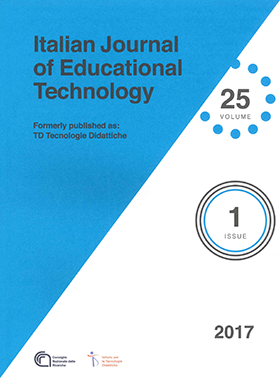Italian in Turkey: intercultural learning in virtual worlds
Main Article Content
Abstract
Article Details
Section
Authors who publish with this journal agree to the following terms:
- Authors retain copyright and grant the journal right of first publication with the work simultaneously licensed under a Creative Commons CC BY 4.0 Attribution 4.0 International License.
- Authors are able to enter into separate, additional contractual arrangements for the non-exclusive distribution of the journal's published version of the work (e.g., post it to an institutional repository or publish it in a book), with an acknowledgement of its initial publication in this journal.
- Authors are permitted and encouraged to post their work online (e.g., in institutional repositories or on their website) prior to and during the submission process, as it can lead to productive exchanges, as well as earlier and greater citation of published work (See The Effect of Open Access)
References
Alessandri, G. (2008). Dal desktop a Second Life - Tecnologie nella didattica. Perugia, Italy: Morlacchi.
Banzato M., & Corcione, D. (2008). Second Life. La grande guida. Bologna, Italy: CLUEB.
Bernardi, U. (2004). Cultura e integrazione. Uniti dalle diversità. Milano, Italy: Franco Angeli.
Buchanan, J., Wilson, S. T., & Gopal, N. (2008). A cross cultural virtual learning environment for students to explore the issue of racism: A case study involving the UK, USA and SA. Social Work Education: The International Journal, 27, 671–682. Retrieved from http://bit.ly/2hjGC2A
Chia, R. C., Poe, E., & Singh, P. (2008). An interactive virtual global cultural course: Building a real time cost effective global collaborative learning environment. Journal of Educational Technology Systems, 3, 32–35. Retrieved from https://hal.archives-ouvertes.fr/hal-00197277/document
Chittaro, L., & Serra, M. (2004). Web3D technologies in education: Motivations, issues, opportunities. Proceedings of the 1st International Workshop on Web3D Technologies in Learning, Education, and Training, (pp. 3–7), September 30–October 1. Udine, Italy. Retrieved from http://bit.ly/2hg4aDK
De Martin, M. (2011). Istanbul. Milano, Italy: Mondadori.
Diehl, W. C., & Prins, E. (2008). Unintended outcomes in Second Life: Intercultural literacy and cultural identity in a virtual world. Language and Intercultural Communication, 8, 101–118. Retrieved from https://www.learntechlib.org/p/75662
Dupuy, K. (2008). Education for peace. Oslo, Norway: International Peace Research Institute (PRIO) and Save the Children Norway.
Groom, V., Bailenson, J. N., & Nass, C. (2009). The influence of racial embodiment on racial bias in immersive virtual environments. Social Influence, 4, 231–248. Retrieved from http://stanford.io/2hPKLub
Fedeli, L. (2013). Embodiment e mondi virtuali. Implicazioni didattiche. Milano, Italy: Franco Angeli.
Guiraud, P. (1965). Les Mots Etrangers. Paris, France: Presses Universitaires de France.
Hasler, B. S. (2011). Intercultural Collaborative Learning in Virtual Worlds. Cutting-edge Technologies in Higher Education, 4, 265–304. Bingley, UK: Emerald Group Publishing Limited.
Koester, J., & Olebe, M. (1988). International Journal of Intercultural Relations, 12(3), 233-246.
Liu, Y., & Hannafin, R. D. (2010). Exploring student identity in an intercultural web assisted scientific inquiry project. Journal of Research in International Education, 9, 124–140. doi:10.1177/1475240910370814
Meddings L., Thornbury S. (2009). Teaching Unplugged. London, UK: Delta Teacher Development Series.
Özön, M. N. (1962). Türkçe-Yabancı Kelimeler Sözlüğü. Istanbul, Turkey: Ġnkılap Kitabevi.
Page, J. S. (2004). Peace education: Exploring some philosophical foundations. International Review of Education, 50(1), 3-15.
Pigozzi, M. J. (2006). A UNESCO view of global citizenship education. Educational Review, 58(1), 1-4.
Rutka, S., & Caon F. (2004). La lingua in gioco. Perugia, Italy: Guerra.
Savolainen, K. (2010). Education as a means to world peace: The case of the 1974 UNESCO recommendation.
Simsek, I., & Can, T. (2016). The Design and Use of Educational Games in 3D Virtual Worlds. In Proceedings of Society for Information Technology & Teacher Education International Conference 2016 (pp. 611-617).
Thornbury, S. (2000). A Dogma for EFL" (153). In IATEFL, 2. Retrieved from http://bit.ly/1yAMrKQ
Unesco (2008). UNESCO’S Work on Education for Peace and Non-Violence. Building Peace through Education. Retrieved from http://unesdoc.unesco.org/images/0016/001607/160787e.pdf

